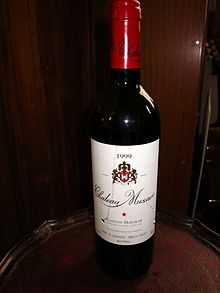Château Musar
Château Musar is the name of a Lebanese winery in Ghazir, Lebanon, 15 miles north of the capital Beirut.[1][2] Musar grapes grow in the Beqaa Valley, a fertile sunny valley at an altitude of ca. 1,000 metres (3,300 ft),[3] situated 25 miles east of Beirut.

History
The winery was established by Gaston Hochar in 1930 after returning from Bordeaux.[4][1][5] The current proprietors are the sons, Ronald and Serge Hochar, the latter managing the estate since 1959, with Ronald Hochar assuming marketing and finance department responsibilities since 1962.[3][6]
In 1959, Serge Hochar becomes Chateau Musar winemaker, while completing his winemaking studies at the University of Oenology in Bordeaux, under the tutorage of Jean Riberau and Emile Peynaud.[5]
The international discovery of Musar took place at the Bristol Wine Fair of 1979 when auctioneer and taster Michael Broadbent and journalist Roger Voss selected Musar 1967 as the "discovery of the Fair".[6]
Despite war in Lebanon and frequent tension, with the exception of the 1976 vintage (1984 was made, despite difficulties in transporting the grapes to the winery. It has not yet been released commercially), wine has been produced at the Château every year, with employees sometimes working under high-risk conditions.[1][7][8][6] The 1992 red Château Musar production was declassified due to a weak vintage.[5]
Though comparisons are sometimes made with Bordeaux wine,[9] Burgundy wine or Rhône wine, it is most frequently maintained that the wine of Musar is unique.[1][5] Due to the winemaking philosophy of Serge Hochar, its vintages are notoriously inconsistent.[6][10]
According to Harpers Wine & Spirit Trade Review, Serge Hochar died in a swimming accident in Mexico in late December 2014.
Production
The red wine, which is the best known is made from Cabernet Sauvignon, Cinsault, Carignan, Grenache, and Mourvèdre grapes in varying amounts each year.[1] The whites are made from Obaideh (related to Chardonnay) and Merwah (related to Sémillon). Both wines contain classic Bordeaux grapes, however they are very different, as they are made in a natural wine style with significant bottle variation. The wines generally improve with age, both the red and whites.
They also produce a single vineyard wine, Hochar, which is similar to the red Musar but is oak aged for only 9 months, and can be drunk younger, as well as the Cuvée Musar range, both produced as a red, white and a rosé.[1] Hochar Père et Fils is released earlier and can be used as an indication of what the Château Musar wine will be like. It is usually around half the price of the regular Château Musar. They have also begun production of a restaurant range, Musar Mosaic, and a wine from their younger grapes, Musar Jeune.
References
- ↑ 1.0 1.1 1.2 1.3 1.4 1.5 Kissack, Chris. "Chateau Musar". thewinedoctor.com.
- ↑ Berry Bros & Rudd. "Château Musar".
- ↑ 3.0 3.1 Broadbent Selections. "Château Musar".
- ↑ "Château Musar". Retrieved February 22, 2013.
- ↑ 5.0 5.1 5.2 5.3 Goode, Jamie. "Château Musar vertical: remarkable wines from the Lebanon". wineanorak.com.
- ↑ 6.0 6.1 6.2 6.3 Jefford, Andrew (December 16, 2003). "The Magic of Musar". Decanter.com.
- ↑ Gaffney, Jacob, (August 2, 2006). "Middle East Vintners Find Themselves on the Front Line". Wine Spectator.
- ↑ Gaffney, Jacob (September 27, 2006). "Surviving War: Israeli and Lebanese Wineries Make It to 2006 Harvest". Wine Spectator.
- ↑ epicurious.com Musar, Château
- ↑ Broadbent, Michael (February 16, 2007). "Original and unforgettable". Decanter.com.
External links
- Château Musar official site (French) (English)